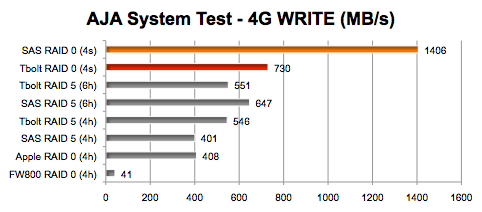SHOOTOUT:
Thunderbolt RAID
versus other RAID storage options
Posted Tue, July 12th, 2011, by rob-ART morgan, mad scientist
Updated September 14th, 2011, with new target mode results
after fimrware upgrade of 2011 MacBook Air.
While we were waiting to get our hands on a Thunderbolt enclosure, one of our "remote mad scientists" has a 2011 iMac connected to a Promise Pegasus R6 Thunderbolt RAID enclosure -- six HDDs configured in RAID 5 mode. He agreed to run some tests for us. To put it in perspective, we compared it to a six drive RAID 5 set running on a SAS/SATA host adapter on the Mac Pro.
Then we heard from a "remote mad scientist" with a Promise Pegasus R4 Thunderbolt RAID enclosure -- four HDDs in RAID 5 mode. So we added those results. Finally we had a Pegasus R4 Thunderbolt RAID enclosure in the lab. We immediate switched the factory HDDs out for four OWC 6Gb/s SSDs. Then, using the Promise RAID Utility, we set up our RAID 0 set.
AJA System Test was used to measure large sequential read and write speed. Settings were 4.0GB File Size, 2048x1556 10-bit RGB Video Frame Size, 335 frames, file system cache disabled. (RED bar indicates the fastest Thunderbolt config; ORANGE bar indicates the fastest SAS config.)


GRAPH LEGEND
SAS RAID 0 (4s) = Stardom ST8-U5 enclosure (four 240G OWC 6G SSDs in RAID 0 mode) connected to a HighPoint RocketRAID 2722 installed in PCie 2.0 slot #2 of 2010 Mac Pro Westmere.
Tbolt RAID 0 (4s) = Promise Pegasus R4 Thunderbolt RAID enclosure (four 240G OWC 6G SSDs in RAID 0 mode) connected to a 2011 iMac 3.4GHz Core i7
Tbolt RAID 5 (6h) = Promise Pegasus R6 Thunderbolt RAID enclosure (six 2TB Hitachi 7K3000s in RAID 5 mode) connected to a 2011 iMac 3.4GHz Core i7
SAS RAID 5 (6h) = iStoragePro iT8 6G SAS Expander (six 2TB Hitachi 7K3000s in RAID 5 mode) connected to a HighPoint RocketRAID 2744 installed in a PCIe slot #2 of 2010 Mac Pro Westmere
Tbolt RAID 5 (4h) = Promise Pegasus R4 Thunderbolt RAID enclosure (four 1TB Hitachi 7K1000s in RAID 5 mode) connected to a 2011 iMac 3.4GHz Core i7
SAS RAID 5 (4h) = iStoragePro iT8 6G SAS Expander (four 2TB Hitachi 7K3000s in RAID 5 mode) connected to a HighPoint RocketRAID 2744 installed in a PCIe slot #2 of 2010 Mac Pro Westmere
Apple RAID 0 (4h) = Apple's proprietary Pro RAID card connected to four Seagate Cheetah 15K.6 450GB SAS drives installed in PCIe slot #4 of a 2009 Mac Pro Nehalem
FW800 RAID 0 (4h) = Wiebetech RTX 400H-QJ enclosure (four 1TB Seagate Barracuda 7200.12s in RAID 0 mode; four FW800 ports daisy chained) connected to the 2011 iMac's FireWire 800 single data port.
INSIGHTS
1. Thunderbolt is faster than FireWire 800 by a long shot, as expected.
2. Thunderbolt RAID 5 on the iMac is not quite as fast as our SAS RAID 5 scenario on a Mac Pro, but it shows you don't need a Mac Pro to have fast external storage.
3. Thunderbolt RAID 0 with 6Gb/s SSDs appears to run into a bottleneck when you compare it to the SAS RAID 0 with the same 6Gb/s SSDs. I guess the 1000+MB/s theoretical bandwidth is... theoretical.
4. Thunderbolt just made Apple's Pro RAID card obsolete.
THUNDERBOLT in TARGET DISK MODE (Updated Sept 14th, 2011)
We tested Target Disk Mode with a Thunderbolt cable between two 2011 MacBook Pros with internal "Apple" SSDs. It was disappointing. The transfer speed for a 1.2G document topped out at 62MB/s. Quickbench large block transfers measured 62MB/s read, 40MB/s write. Why so slow? Because Target Mode uses EFI. That means the multi-threaded, multi-block DMA transfers possible under OS X are not available for Target mode. Of course, the same limitation affects FireWire 800 in Target Disk Mode. Instead of 80MB/s, it tops out at 40MB/s. At least you could say that Target Disk Mode with Thunderbolt is 50% faster than FireWire.
After September 12th EFI Firmware Update 2.1 on the 2011 MacBook Air, we repeated our Target Disk Mode tests. The large document Finder copy measured 109MB/s. The QuickBench large block transfer test measured 117MB/s READ and 67MB/s WRITE. That's a big improvement over our July Target Disk Mode results above, but still much slower than the full speed of the internal flash storage of the MacBook Air used in the test (270MB/s) -- or the full bandwidth of Thunderbolt under OS X (1000MB/s).
To be notified of new test results, subscribe to our RSS feed or follow us on Twitter@barefeats. If you have a question, comment, or want to volunteer as a remote mad scientist,
.
WHERE TO BUY THUNDERBOLT and OTHER APPLE PRODUCTS
When you purchase Apple USA products, please CLICK THIS LINK or any APPLE BANNERS on this site. It's a great way to support Bare Feats. since we earn a commission on each click-through that results in a sale.